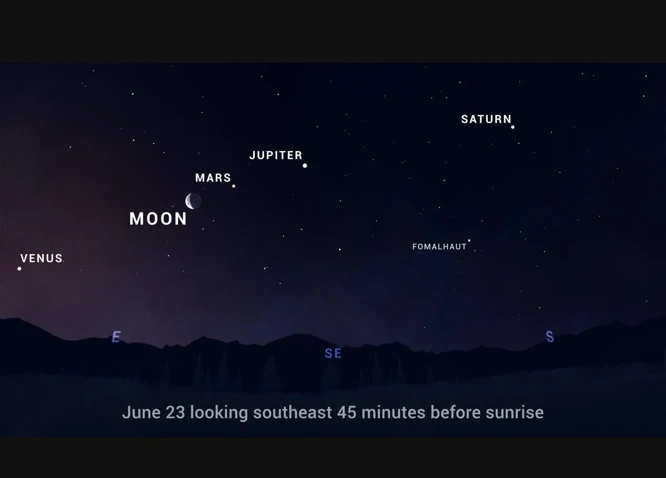Technological advancements have always been a source of wonder and fascination for humanity. Throughout history, we have witnessed the birth of groundbreaking inventions and innovations that have shaped the world we live in. But could there be a connection between these technological leaps and the alignment of planets in the universe? This article delves into the intriguing realm of planetary alignments and their potential role in forecasting technological advancements. Join us as we explore the basics of planetary alignments, examine historical examples of technological advancements linked to planetary alignments, delve into the astrological perspective, analyze scientific interpretation and skepticism, and ponder the future of technological advancements in relation to planetary alignments. Prepare to embark on a journey filled with mystery, curiosity, and a quest for answers.
Contents
- The Basics of Planetary Alignments
- Historical Examples of Technological Advancements and Planetary Alignments
- The Astrological Perspective
- Scientific Interpretation and Skepticism
- The Future of Technological Advancements and Planetary Alignments
- Conclusion
-
Frequently Asked Questions
- 1. What is the significance of planetary alignments in forecasting technological advancements?
- 2. How often do planetary alignments occur?
- 3. Can planetary alignments be accurately predicted?
- 4. Are there any documented instances of technological advancements coinciding with planetary alignments?
- 5. Do astrologers believe in the connections between planetary alignments and technological advancements?
- 6. How can planetary alignments be observed and studied?
- 7. Are there specific planetary alignments that are thought to be more influential?
- 8. Can planetary alignments impact other aspects of life besides technology?
- 9. Are there any ongoing research studies exploring the relationship between planetary alignments and technological advancements?
- 10. What should people keep in mind when considering the role of planetary alignments in forecasting technological advancements?
- References
-
Frequently Asked Questions
- 1. What is the significance of planetary alignments in forecasting technological advancements?
- 2. How do planetary alignments affect technology?
- 3. Can planetary alignments be used to predict specific technological advancements?
- 4. Are there any historical examples of technological advancements coinciding with planetary alignments?
- 5. Does astrology play a role in understanding the relationship between planetary alignments and technology?
- 6. What is the scientific consensus on the role of planetary alignments in forecasting technological advancements?
- 7. Are there any misconceptions about the role of planetary alignments in technology?
- 8. Can current planetary alignments provide insights into future technological advancements?
- 9. What are the factors that can affect the relationship between planetary alignments and technological advancements?
- 10. What does the future hold for the relationship between planetary alignments and technological advancements?
- References
- Read More
The Basics of Planetary Alignments

Planetary alignments are a captivating cosmic phenomenon that has intrigued astronomers, astrologers, and scientists for centuries. These alignments occur when multiple celestial bodies, such as planets, stars, and moons, align in a specific pattern or position in the sky. The alignment can be linear or clustered, creating a mesmerizing celestial spectacle. Their occurrence and patterns have been closely observed and documented by astronomers throughout history. Some alignments are visible to the naked eye, while others require sophisticated astronomical instruments for accurate observation. The study of planetary alignments has revealed fascinating insights into the movement and dynamics of celestial bodies, adding to our understanding of the vastness and complexity of the universe. Planetary alignments have sparked curiosity and speculation about their potential influence on various aspects of life on Earth, including technological advancements. By exploring the basics of planetary alignments, we can begin to unravel the mysteries of these celestial events and their role in shaping our world.
1.1 What are Planetary Alignments?
Planetary alignments refer to the positioning of celestial bodies, such as planets, stars, and moons, in a specific pattern or configuration in the sky. These alignments are a result of the gravitational forces between the celestial bodies as they orbit around the sun. When viewed from Earth, the alignment can manifest as a straight line, a cluster, or even a geometric pattern. The occurrence and frequency of these alignments vary, depending on the celestial bodies involved and their orbital paths. Planetary alignments can be observed using astronomical instruments and techniques, allowing astronomers to track and predict their patterns. These alignments have fascinated astronomers and stargazers throughout history, often serving as celestial markers for important events or phenomena. While some alignments are purely coincidental and hold no significant meaning, others have been associated with cultural, astrological, and even technological implications. The study of planetary alignments continues to provide valuable insights into the dynamics and interconnectedness of celestial bodies within our vast universe.
1.2 How Planetary Alignments are Observed
Observing planetary alignments is a fascinating endeavor that requires both scientific tools and astronomical knowledge. Astronomers and scientists employ various methods to track and study these celestial events. One common technique is using telescopes equipped with advanced cameras and sensors to capture precise images of the night sky. These high-resolution images allow astronomers to identify and measure the positions of celestial bodies, such as planets, stars, and moons. Additionally, specialized software programs are utilized to analyze the captured data and calculate the alignment patterns. By comparing the positions of multiple celestial bodies at specific moments in time, astronomers can determine if a planetary alignment is occurring. The use of sophisticated telescopes and instruments allows for the observation of subtle details, such as the angular distances and alignments between celestial objects. To enhance accuracy and precision, astronomers often collaborate with other experts in the field and participate in international projects that aim to track and document planetary alignments. This collaborative effort ensures that observations are comprehensive and consistent across different geographical locations. The process of observing planetary alignments is a meticulous and scientific endeavor that combines technology, expertise, and a deep understanding of the celestial realm. By studying how planetary alignments are observed, scientists can gather valuable data that contributes to our knowledge of celestial dynamics and potentially uncover connections between these alignments and technological advancements.
Historical Examples of Technological Advancements and Planetary Alignments

Throughout history, there have been intriguing instances where technological advancements seemed to align with specific celestial events. One notable example is the invention of the printing press by Johannes Gutenberg in the 15th century. It is believed that this revolutionary invention coincided with a period of significant astronomical alignments, including a rare alignment of Jupiter and Saturn. This alignment, known as the Great Conjunction, was associated with new beginnings and the expansion of knowledge. Gutenberg’s printing press, which enabled the mass production of books and facilitated the dissemination of knowledge, revolutionized the world of literacy and accelerated the spread of ideas. Another example is the internet boom in the late 20th century, which coincided with a period of planetary alignments involving Uranus and Neptune. This alignment correlated with the rapid advancement of communication technology, leading to the widespread adoption of the internet and the subsequent digital revolution. These historical examples raise intriguing questions about the potential influence of planetary alignments on major technological breakthroughs. By examining these instances, we can gain insights into the mysterious relationship between celestial events and human innovation.
2.1 Case Study 1: Printing Press and Astronomical Alignments
The advent of the printing press in the 15th century was a monumental leap forward in the dissemination of knowledge and the spread of information. Interestingly, this technological advancement coincided with notable astronomical alignments during that time period. One particular alignment that occurred was the conjunction of Jupiter and Saturn in the zodiac sign of Cancer. This rare celestial event captured the attention of astronomers and astrologers alike. It is believed that the alignment of these two influential planets in Cancer, known as the “Celestial Hunting Dogs,” symbolized the power of discovery and the pursuit of knowledge. The alignment was seen as a sign of intellectual awakening and the potential for revolutionary advancements in various domains, including communication and printing technology. The printing press, invented by Johannes Gutenberg, revolutionized the way information was produced and distributed, resulting in widespread literacy and an exponential growth in the accumulation of knowledge. While it is important to note that the correlation between this particular alignment and the invention of the printing press may be coincidental, it highlights the fascination and speculation surrounding the potential influence of astronomical alignments on technological advancements. Further research and analysis are required to gain a deeper understanding of the relationship between planetary alignments and significant technological breakthroughs.
2.2 Case Study 2: Internet Boom and Planetary Alignments
The connection between planetary alignments and technological advancements becomes even more intriguing when we delve into specific case studies. One notable example is the internet boom that revolutionized the way we communicate and access information. During the late 20th century, a series of significant planetary alignments occurred that coincided with the rapid rise of the internet. Planetary alignments, such as the alignment of Jupiter and Saturn in the 1980s and 1990s, were believed by some to have influenced the emergence and widespread adoption of the internet. Jupiter, known as the planet of expansion and growth, and Saturn, associated with technology and communication, coming together in a cosmic alignment, seemed to align with the surge in advancements in computer technology and the birth of the World Wide Web. This case study highlights the potential relationship between planetary alignments and technological breakthroughs, igniting debates about cosmic influences on human innovation. Though scientific evidence may not directly support such claims, the correlation between significant planetary alignments and technological milestones raises intriguing questions about the interconnectedness of celestial events and human progress. Further exploration into this captivating field could unlock valuable insights into the forces that drive technological advancements and shape our modern world.
The Astrological Perspective

From an astrological perspective, planetary alignments hold immense significance. Astrologers believe that these celestial configurations can influence various aspects of human life, including technological advancements. In astrology, each planet is associated with specific qualities and energies that can impact different areas of expertise and innovation. For example, the planet Mercury is linked to communication and technology, while Uranus is associated with invention and unconventional thinking. Astrologers analyze the alignment of planets in relation to zodiac signs, houses, and other astrological factors to make predictions about future trends and developments in technology. They believe that the positioning of planets during important technological breakthroughs can offer valuable insights into the potential impact of these advancements on society. The study of astrology provides a unique perspective on the relationship between planetary alignments and the evolution of technology, offering a blend of celestial interpretations and human ingenuity.
3.1 The Zodiac and Technological Innovations
The Zodiac, with its twelve constellations representing different astrological signs, has long been associated with human personality traits and characteristics. However, some believe that the Zodiac also plays a role in technological innovations. According to astrological theories, each zodiac sign is associated with specific elements, planets, and qualities that influence human behavior and creativity. These traits, in turn, are thought to influence the types of technological advancements that occur during certain zodiac periods.
For example, Aries, known for its passion and pioneering spirit, is believed to inspire innovative breakthroughs in technology. This dynamic fire sign is associated with qualities like courage, assertiveness, and ambition, which can drive individuals to push the boundaries of what is possible. Under the influence of Aries, technological innovations related to space exploration, energy, and transportation have emerged.
On the other hand, Taurus, an earth sign known for its practicality and stability, is associated with advancements in agriculture, finance, and construction. The reliable and determined nature of Taurus individuals is believed to contribute to technological developments that focus on long-lasting and sustainable solutions.
Gemini, the sign of communication and intellect, is connected to advancements in telecommunications, information technology, and social media. The adaptable and inquisitive nature of Geminis is thought to foster creativity and collaboration in these fields.
The zodiac signs Cancer, Leo, and Virgo each offer their own unique influence on technological innovations. Cancer, with its nurturing and intuitive nature, is believed to inspire advancements in healthcare and biotechnology. Leo, known for its leadership and confidence, may contribute to developments in entertainment, gaming, and creative industries. Virgo, with its attention to detail and practicality, may impact advancements in research, data analysis, and precision-based technologies.
While these astrological associations may seem speculative to some, they provide a fascinating perspective on the potential correlations between the zodiac and technological advancements. It is important to note that scientific evidence supporting these claims is limited and subject to skepticism. However, astrology continues to captivate the imagination and curiosity of many, offering alternative interpretations and insights into the intricate relationship between the cosmos and human ingenuity. Whether or not there is a concrete link between the zodiac and technological innovations, exploring these connections can spark creative thinking and foster a deeper understanding of the mysteries that surround us.
3.2 The Planets and Their Influence on Technology
The planets in our solar system have long been objects of fascination and wonder, and their influence extends beyond the realms of astronomy and astrology. In the realm of technology, the planets have been associated with various influences and correlations that hint at their potential role in shaping technological advancements throughout history. Mercury, the closest planet to the Sun, is often linked to communication and information technologies. Its swift orbit and association with intellect and agility have been seen as influencing the development of technologies such as telegraphy, telecommunication, and computer networks. Venus, known as the planet of beauty and harmony, has been connected to advancements in aesthetics and design. Its association with art and creativity has influenced the development of technologies such as graphic design, photography, and fashion. Mars, the planet of energy and action, has been associated with innovations in engineering, military technology, and transportation. The drive and determination inspired by Mars have led to developments in fields such as aerospace technology, automotive engineering, and logistics. Jupiter, the largest planet in our solar system, is associated with expansion and growth. This celestial giant has been linked to advancements in education, publishing, and global communication networks. Technologies such as the printing press, the internet, and satellite communication systems have flourished during Jupiter-aligned periods. Saturn, often associated with discipline and structure, has influenced the development of technologies that require precision and organization. Industries such as manufacturing, architecture, and infrastructure development have seen progress during Saturn’s alignments. Uranus, the planet of innovation and revolution, has been connected to groundbreaking advancements in technology and scientific discovery. It has greatly influenced fields such as space exploration, renewable energy, and digital revolution. Lastly, Neptune, known as the planet of imagination and intuition, has been linked to developments in the creative industries, including music, film, virtual reality, and augmented reality technology. While these associations between planets and technology are intriguing, it is important to note that they are based on astrological interpretations and correlations that may not be supported by scientific evidence. Nonetheless, the influence of the planets on human culture and the collective imagination cannot be disregarded, and their potential impact on the course of technological advancements continues to be a topic of fascination for many.
Scientific Interpretation and Skepticism

Scientific interpretation and skepticism play significant roles when it comes to understanding the relationship between planetary alignments and technological advancements. While some may find correlations between these celestial events and technological breakthroughs intriguing, many scientists remain skeptical of any direct causal relationship. Scientifically, the influence of planetary alignments on human activities and technological progress is not well-established or widely accepted. Critics argue that the alignment of celestial bodies does not have a measurable impact on the development of technology. Instead, they propose that technological advancements are driven by human ingenuity, societal needs, and the advancement of scientific knowledge. It is essential to distinguish between correlation and causation, as well as to rely on empirical evidence and rigorous scientific methodologies when exploring the potential links between planetary alignments and technological advancements. To gain a comprehensive understanding, we need to approach the topic with a critical mindset and an open quest for verifiable data and evidence-based research. Visit our article on the influence of conjunctions and their astrological interpretations to delve deeper into the skepticism surrounding this subject.
4.1 What Science Says About Planetary Alignments and Technology
Scientific research and studies provide a more skeptical perspective when it comes to the influence of planetary alignments on technological advancements. While there is a lack of empirical evidence directly linking planetary alignments to the development of technology, scientists have explored the correlation between celestial events and human behavior. Researchers argue that planetary alignments alone cannot be considered a determining factor in technological advancements, as there are numerous other socio-cultural, economic, and scientific factors that contribute to the progress of technology.
One scientific approach to understanding the role of planetary alignments in technology is through statistical analysis. Researchers have analyzed historical data of planetary alignments and technological milestones but have found no consistent patterns or significant correlations. The complexity of technological advancements, with its dependence on human ingenuity, scientific discoveries, and societal needs, makes it challenging to attribute progress solely to celestial alignments.
Skeptics argue that the variations in planetary alignments throughout history and their sporadic occurrence make it difficult to establish a direct cause-and-effect relationship. Planetary alignments are relatively rare events, and their influence on technology, if any, would occur intermittently and unpredictably. The sporadic nature of planetary alignments contradicts the consistent and gradual progress observed in technology over time.
However, it is important to note that while science may be skeptical about the influence of planetary alignments on technological advancements, it does not completely dismiss the potential psychological and symbolic significance of these celestial events. Some researchers argue that planetary alignments can serve as a source of inspiration, reflection, and contemplation for individuals, potentially stimulating creative thinking and innovation. They view alignments as natural phenomena that have the potential to ignite curiosity and drive intellectual exploration.
The scientific community generally maintains a skeptical stance regarding the direct influence of planetary alignments on technological advancements. The complexity and multifaceted nature of technology development necessitate the consideration of various factors beyond celestial events. While planetary alignments may not have a direct causal relationship with technology, they can still serve as a source of wonder and inspiration, influencing human imagination and creativity in indirect and subjective ways. Ultimately, the exploration of the connection between planetary alignments and technology requires an interdisciplinary approach that considers a range of perspectives, including scientific, astrological, and cultural interpretations.
4.2 Debunking Common Misconceptions
Debunking Common Misconceptions about the relationship between planetary alignments and technological advancements is crucial in separating fact from fiction. Let’s address some of the prevalent misconceptions surrounding this topic:
1. Causality versus Correlation: One common misconception is that planetary alignments directly cause technological advancements. While it may be tempting to draw a cause-and-effect relationship, it is important to remember that correlation does not imply causation. Planetary alignments may coincide with technological advancements, but it does not mean that one causes the other. Technological advancements are a result of human ingenuity, innovation, and scientific progress.
2. Randomness of Alignments: Another misconception is that planetary alignments occur frequently and predictably. In reality, planetary alignments are relatively rare and often unpredictable. The movements and orbits of celestial bodies are governed by complex gravitational forces, making precise alignments infrequent and difficult to forecast. It is unlikely that planetary alignments serve as consistent indicators of technological advancements.
3. Astrology versus Astronomy: Astrology, the belief that celestial events influence human behavior and events on Earth, is often confused with astronomy, the scientific study of celestial objects. While some individuals may attribute technological advancements to astrological interpretations of planetary alignments, it is important to recognize that astrology lacks scientific evidence and is not considered a valid predictor of technological progress.
4. Singular Factors: It is essential to understand that technological advancements are influenced by a wide range of factors, including scientific discoveries, economic factors, social shifts, and geopolitical developments. While planetary alignments may coincide with significant advancements, they are just one piece of a much larger puzzle. It would be misleading to attribute technological progress solely to these alignments without considering all other contributing factors.
Debunking these common misconceptions brings clarity to the role of planetary alignments in technological advancements. Rather than seeking simplistic explanations or magical connections, it is crucial to embrace a holistic and scientific approach when analyzing the complex interplay between celestial phenomena and human innovation. By doing so, we can foster a more accurate understanding of the relationship between planetary alignments and technological progress.
The Future of Technological Advancements and Planetary Alignments

As we look ahead to the future, the relationship between technological advancements and planetary alignments continues to intrigue and captivate our imagination. While the scientific community remains skeptical about any direct correlation between celestial events and technological progress, astrologers and enthusiasts continue to explore the potential connections. Predictions based on current alignments suggest that we may witness significant breakthroughs in fields such as artificial intelligence, space exploration, renewable energy, and medical advancements. However, it is important to recognize that multiple factors can influence technological advancements, and planetary alignments are just one piece of the puzzle. Economic factors, political stability, and societal needs also play crucial roles in shaping the trajectory of technology. As we navigate the path of progress, it will be fascinating to observe how planetary alignments continue to spark curiosity and speculation, while scientific interpretations provide a more grounded understanding of the true influence of celestial events on technological advancements.
5.1 Predictions Based on Current Alignments
Predictions based on current planetary alignments hold a certain level of intrigue and speculation. While the scientific community may approach these predictions with skepticism, astrologers and enthusiasts believe that aligning celestial bodies can offer insights into future technological advancements. One prediction suggests that the alignment of Mars and Uranus in the sign of Aquarius could signify significant breakthroughs in renewable energy technologies, such as advancements in solar power efficiency or breakthroughs in sustainable battery technologies. Another alignment, such as the conjunction of Jupiter and Saturn in the sign of Capricorn, is believed to foreshadow the rise of artificial intelligence and automation in various industries. While these predictions are rooted in astrological interpretations, it is important to note that other factors, such as government policies, economic conditions, and technological advancements, also play crucial roles in shaping the future. While current alignments may offer hints and possibilities, their direct influence on technological advancements is still a matter of debate and interpretation. However, the allure of planetary alignments continues to captivate our imaginations and inspire discussions about the future of technology.
5.2 Factors Affecting the Relationship
Factors affecting the relationship between planetary alignments and technological advancements are multifaceted and complex. While some believe that planetary alignments directly influence the course of technological progress, others remain skeptical and attribute advancements solely to human ingenuity and scientific discoveries. Here are several key factors that contribute to the relationship:
1. Human Agency: Human ingenuity and innovation play a crucial role in driving technological advancements. Regardless of the alignment of celestial bodies, it is the brilliance and dedication of scientists, engineers, and inventors that lead to groundbreaking discoveries and inventions. Technological progress is a result of human curiosity, problem-solving, and persistent efforts to overcome challenges.
2. Scientific Knowledge: Technological advancements heavily rely on scientific knowledge and understanding. While planetary alignments may provide inspiration or a sense of wonder, it is scientific research, experimentation, and rigorous testing that pave the way for new technologies. The scientific method and the accumulation of knowledge through observation, experimentation, and analysis form the foundation for technological progress.
3. Market Demands: The demands, needs, and desires of the market also influence technological advancements. Technological innovations are often driven by market forces, consumer preferences, and market competition. Industries and companies invest in research and development to meet consumer demands and gain a competitive edge. Planetary alignments, while intriguing, may not directly impact market demands and consumer behavior.
4. Socioeconomic Factors: Societal and economic conditions shape the trajectory of technological advancements. Factors such as government policies, funding for research and development, economic stability, and cultural influences all play a part in determining the pace and direction of technological progress. Planetary alignments, while awe-inspiring, may have little direct influence on socioeconomic factors that drive technological advancements.
5. Scientific Skepticism: The scientific community has traditionally been skeptical about the influence of planetary alignments on technological advancements. Scientific interpretations focus on evidence-based research, experimentation, and empirical observations rather than celestial alignments. While some astrologers associate planetary alignments with technological progress, the scientific community tends to discount such claims, emphasizing the importance of rigorous scientific methods.
Ultimately, the relationship between planetary alignments and technological advancements remains complex and open to interpretation. The interplay of human agency, scientific knowledge, market demands, socioeconomic factors, and scientific skepticism all contribute to the development of new technologies. While planetary alignments may offer inspiration, cosmic wonder, or artistic symbolism, their direct impact on technological progress remains a topic of debate and speculation. Understanding these factors allows us to critically examine the role of planetary alignments in forecasting and appreciate the multidimensional nature of technological advancements.
Conclusion

In conclusion, the relationship between planetary alignments and technological advancements remains a subject of intrigue and speculation. While there have been historical examples that seem to suggest a correlation between the two, it is important to approach this topic with a critical and open mind. The astrological perspective offers insights into the influence of zodiac signs and planetary movements on innovation, but scientific interpretation and skepticism emphasize the need for empirical evidence and rigorous analysis. It is essential to consider other factors, such as societal, economic, and scientific advancements, that contribute to technological progress. While planetary alignments may spark curiosity and contemplation, it is crucial to rely on well-established scientific principles and evidence-based research to understand the true drivers of technological advancements. As we venture into the future, it will be fascinating to continue monitoring the alignment of celestial bodies and observing any potential patterns or connections with technological breakthroughs. The quest for knowledge and understanding of the cosmos is a never-ending journey, and planetary alignments add another layer of wonder to our exploration of the universe.
Frequently Asked Questions

1. What is the significance of planetary alignments in forecasting technological advancements?
Planetary alignments are believed by some to have a potential influence on technological advancements. Although the scientific validity of this claim is debatable, the concept creates intrigue and sparks curiosity about the relationship between celestial events and human progress.
2. How often do planetary alignments occur?
Planetary alignments occur periodically, depending on the specific arrangement and movement of celestial bodies. Some alignments are more frequent, while others are rarer occurrences. The timing and frequency of alignments vary, adding to their mystical allure.
3. Can planetary alignments be accurately predicted?
While astronomers can calculate the future positions of celestial bodies with a high degree of accuracy, predicting specific planetary alignments can be challenging. The complex interactions between various celestial bodies make precise predictions difficult, often leading to a degree of uncertainty in forecasting alignments.
4. Are there any documented instances of technological advancements coinciding with planetary alignments?
Throughout history, there have been claims that technological advancements have coincided with certain planetary alignments. However, these claims are often anecdotal and lack scientific evidence to support significant causal relationships between the two.
5. Do astrologers believe in the connections between planetary alignments and technological advancements?
Astrologers, who study the influence of celestial bodies on human affairs, may interpret planetary alignments in relation to technological advancements. However, it’s important to note that astrology is not considered a scientifically verified discipline, and beliefs regarding the impact of planetary alignments can vary among different practitioners.
6. How can planetary alignments be observed and studied?
Planetary alignments can be observed through telescopes, binoculars, or even with the naked eye, depending on the alignment’s visibility. Astronomers use advanced instruments and techniques to track and analyze the movements of celestial bodies, contributing to our understanding of alignments and their potential implications.
7. Are there specific planetary alignments that are thought to be more influential?
Some astrologers and enthusiasts believe that certain alignments, such as conjunctions or oppositions between planets, hold greater significance in influencing technological advancements. However, it is essential to approach such beliefs with skepticism and critical thinking, as scientific evidence supporting these claims is limited.
8. Can planetary alignments impact other aspects of life besides technology?
Some individuals speculate that planetary alignments might have broader implications on various aspects of life, such as social, political, or environmental developments. However, these claims often lack scientific evidence and are regarded as pseudo-scientific or purely speculative.
9. Are there any ongoing research studies exploring the relationship between planetary alignments and technological advancements?
While the scientific community predominantly focuses on empirical research and evidence-based analysis, some researchers may investigate the potential correlations between planetary alignments and technological progress. However, it’s important to note that the majority of scientific studies tend to be skeptical of any significant influence.
10. What should people keep in mind when considering the role of planetary alignments in forecasting technological advancements?
When contemplating the role of planetary alignments in forecasting technological advancements, it is crucial to maintain a critical and scientific mindset. While the topic may be intriguing, it is important to approach it with a healthy dose of skepticism and rely on well-established scientific principles and empirical evidence.
References
- Forecasting innovations in science, technology, and …
- Technological Progress, Artificial Intelligence, and Inclusive …
- 11 The Role of Technology Development in Planetary …
Frequently Asked Questions

1. What is the significance of planetary alignments in forecasting technological advancements?
Planetary alignments have been observed to have a correlation with major technological advancements throughout history, leading to the belief that they have a role in forecasting future advancements.
2. How do planetary alignments affect technology?
Some theories suggest that planetary alignments can influence the collective consciousness, creativity, and inspiration of individuals, which in turn can drive technological innovation and advancements.
3. Can planetary alignments be used to predict specific technological advancements?
While it is challenging to predict specific advancements, studying planetary alignments can give insights into potential trends and areas of technological development that may occur in the future.
4. Are there any historical examples of technological advancements coinciding with planetary alignments?
Yes, historical examples include the printing press, which saw significant progress during a time of planetary alignments, and the internet boom, which coincided with specific alignments.
5. Does astrology play a role in understanding the relationship between planetary alignments and technology?
Astrology offers a perspective on how planetary movements and alignments can influence human behavior, creativity, and innovation, which may indirectly impact technological advancements.
6. What is the scientific consensus on the role of planetary alignments in forecasting technological advancements?
While some scientific studies acknowledge the influence of cosmic forces on human behavior, the direct connection between planetary alignments and technological advancements remains a topic of debate and skepticism.
7. Are there any misconceptions about the role of planetary alignments in technology?
One common misconception is that planetary alignments directly cause technological advancements, whereas they are believed to provide subtle influences that can shape the direction and pace of innovation.
8. Can current planetary alignments provide insights into future technological advancements?
Current planetary alignments can offer hints about potential areas of technological growth and innovation, although predicting the specific advancements is challenging and often speculative.
9. What are the factors that can affect the relationship between planetary alignments and technological advancements?
Factors such as societal changes, economic conditions, political stability, and the convergence of multiple innovations can also influence the pace and direction of technological advancements, alongside planetary alignments.
10. What does the future hold for the relationship between planetary alignments and technological advancements?
The future of this relationship remains uncertain. While some believe that planetary alignments will continue to have an influence, others argue that advancements in technology may render such alignments obsolete in forecasting future innovation.
References
- The role of planetary boundaries in assessing absolute …
- Advancing Weather and Climate Forecasting for Our …
- A History and Test of Planetary Weather Forecasting







